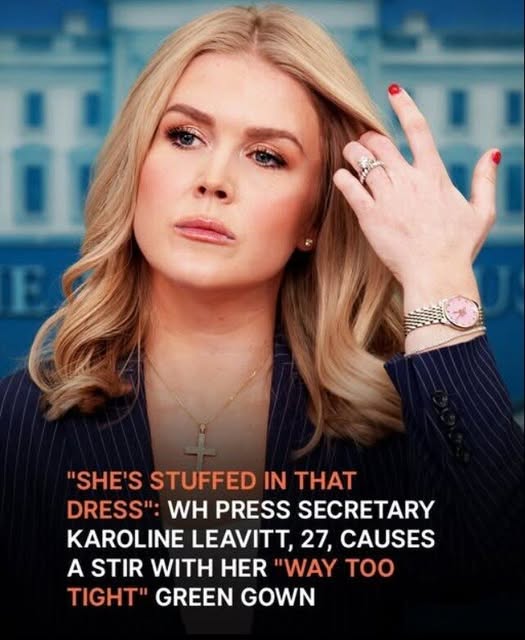On March 31, 2025, White House Press Secretary Karoline Leavitt found herself at the center of public attention—not for the content of her remarks, but for what she wore during a press briefing on the North Lawn. While the occasion was intended to focus on policy updates and official communications, the striking nature of Leavitt’s outfit quickly became the main topic of conversation, sparking widespread debate online and in the media.

Leavitt appeared in an ankle-length green dress that featured a dramatic knee-high slit, a design choice that stood out sharply against the traditionally conservative backdrop of the White House. The deep green fabric contrasted with the spring sunlight, drawing eyes to the ensemble. She paired the dress with brown heels, which added a warm tone to the look but also enhanced its visual impact. In political spaces where attire is often understated, her fashion choice was instantly noticeable—and for many, controversial.
It didn’t take long for images from the briefing to circulate widely across social media platforms. Comments poured in almost immediately, and while reactions were mixed, the dominant tone was critical. Many questioned the fit, appropriateness, and overall styling of the dress for a role as visible and formal as White House Press Secretary. One comment that quickly gained traction read, “She’s stuffed in that dress,” suggesting that the garment appeared tight or poorly tailored. Such critiques were not limited to fit alone; others speculated about the design’s execution, with one social media user remarking, “I think your dress is on backward?” implying a lack of care or attention in her appearance.
For some, the criticism reflected a belief that those in high-profile political positions should adhere to a more conservative dress code—especially when representing the administration on an official stage. The slit, in particular, was seen by detractors as too bold for the setting, overshadowing the professionalism expected in that context. The suggestion that her outfit looked awkward or unconventional underscored the heightened scrutiny public figures, especially women, often face over their clothing choices.
This was not simply a case of fashion commentary—it became a microcosm of a larger conversation about gender, image, and double standards in politics. Female public figures have long been subject to more intense appearance-based criticism than their male counterparts, with attire, body shape, and personal style frequently becoming points of public judgment. In Leavitt’s case, much of the online discourse shifted from evaluating the dress as a piece of clothing to critiquing her body and personal presentation, illustrating how quickly the focus can move from policy to personal image in the political arena.
Supporters of Leavitt pushed back against the criticism, arguing that the uproar was disproportionate and rooted in outdated expectations of how women in government should dress. They contended that her outfit, while striking, did not detract from her role or her ability to deliver information to the public. Some also pointed out the hypocrisy in how male political figures are rarely subjected to this level of sartorial scrutiny, even when their attire deviates from norms.
Nevertheless, the episode demonstrated just how powerful and distracting visual impressions can be in politics. A moment that was meant to inform the public about governmental matters instead turned into a viral talking point about clothing choices. The images from that day—paired with thousands of online comments—reinforced the reality that in the digital age, any public appearance by a political figure can be dissected instantly and spread across the globe within hours.
Ultimately, what began as a routine press event evolved into a conversation about style, perception, and the pressures faced by women in leadership roles. Karoline Leavitt’s green dress and high-slit design may fade from the news cycle in time, but the incident leaves behind a familiar reminder: in politics, image is inseparable from message, and for women in the public eye, the line between personal style and professional expectation remains one of the most closely watched—and hotly debated—boundaries.





